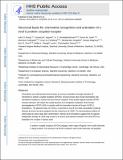Structural basis for chemokine recognition and activation of a viral G protein-coupled receptor
Author(s)
Burg, J. S.; Ingram, J. R.; Venkatakrishnan, A. J.; Jude, K. M.; Dukkipati, A.; Feinberg, E. N.; Waghray, D.; Dror, R. O.; Garcia, K. C.; Angelini, Alessandro; Ploegh, Hidde; ... Show more Show less
DownloadPloegh_Structural biology.pdf (2.060Mb)
OPEN_ACCESS_POLICY
Open Access Policy
Creative Commons Attribution-Noncommercial-Share Alike
Terms of use
Metadata
Show full item recordAbstract
Chemokines are small proteins that function as immune modulators through activation of chemokine G protein–coupled receptors (GPCRs). Several viruses also encode chemokines and chemokine receptors to subvert the host immune response. How protein ligands activate GPCRs remains unknown. We report the crystal structure at 2.9 angstrom resolution of the human cytomegalovirus GPCR US28 in complex with the chemokine domain of human CX3CL1 (fractalkine). The globular body of CX3CL1 is perched on top of the US28 extracellular vestibule, whereas its amino terminus projects into the central core of US28. The transmembrane helices of US28 adopt an active-state–like conformation. Atomic-level simulations suggest that the agonist-independent activity of US28 may be due to an amino acid network evolved in the viral GPCR to destabilize the receptor’s inactive state.
Date issued
2014-12Department
Massachusetts Institute of Technology. Department of Biology; Koch Institute for Integrative Cancer Research at MITJournal
Science
Publisher
American Association for the Advancement of Science (AAAS)
Citation
Burg, J. S. et al. “Structural Basis for Chemokine Recognition and Activation of a Viral G Protein-Coupled Receptor.” Science 347.6226 (2015): 1113–1117.
Version: Author's final manuscript
ISSN
0036-8075
1095-9203